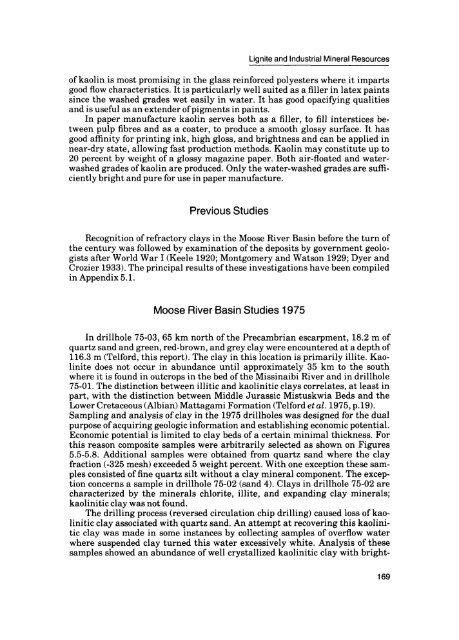Moose River Basin: geology and mineral potential - Geology Ontario
Moose River Basin: geology and mineral potential - Geology Ontario
Moose River Basin: geology and mineral potential - Geology Ontario
You also want an ePaper? Increase the reach of your titles
YUMPU automatically turns print PDFs into web optimized ePapers that Google loves.
Lignite <strong>and</strong> Industrial Mineral Resources<br />
of kaolin is most promising in the glass reinforced polyesters where it imparts<br />
good flow characteristics. It is particularly well suited as a filler in latex paints<br />
since the washed grades wet easily in water. It has good opacifying qualities<br />
<strong>and</strong> is useful as an extender of pigments in paints.<br />
In paper manufacture kaolin serves both as a filler, to fill interstices be<br />
tween pulp fibres <strong>and</strong> as a coater, to produce a smooth glossy surface. It has<br />
good affinity for printing ink, high gloss, <strong>and</strong> brightness <strong>and</strong> can be applied in<br />
near-dry state, allowing fast production methods. Kaolin may constitute up to<br />
20 percent by weight of a glossy magazine paper. Both air-floated <strong>and</strong> waterwashed<br />
grades of kaolin are produced. Only the water-washed grades are suffi<br />
ciently bright <strong>and</strong> pure for use in paper manufacture.<br />
Previous Studies<br />
Recognition of refractory clays in the <strong>Moose</strong> <strong>River</strong> <strong>Basin</strong> before the turn of<br />
the century was followed by examination of the deposits by government geolo<br />
gists after World War I (Keele 1920; Montgomery <strong>and</strong> Watson 1929; Dyer <strong>and</strong><br />
Crozier 1933). The principal results of these investigations have been compiled<br />
in Appendix 5.1.<br />
<strong>Moose</strong> <strong>River</strong> <strong>Basin</strong> Studies 1975<br />
In drillhole 75-03, 65 km north of the Precambrian escarpment, 18.2 m of<br />
quartz s<strong>and</strong> <strong>and</strong> green, red-brown, <strong>and</strong> grey clay were encountered at a depth of<br />
116.3 m (Telford, this report). The clay in this location is primarily illite. Kao<br />
linite does not occur in abundance until approximately 35 km to the south<br />
where it is found in outcrops in the bed of the Missinaibi <strong>River</strong> <strong>and</strong> in drillhole<br />
75-01. The distinction between illitic <strong>and</strong> kaolinitic clays correlates, at least in<br />
part, with the distinction between Middle Jurassic Mistuskwia Beds <strong>and</strong> the<br />
Lower Cretaceous (Albian) Mattagami Formation (Telford etal. 1975, p.19).<br />
Sampling <strong>and</strong> analysis of clay in the 1975 drillholes was designed for the dual<br />
purpose of acquiring geologic information <strong>and</strong> establishing economic <strong>potential</strong>.<br />
Economic <strong>potential</strong> is limited to clay beds of a certain minimal thickness. For<br />
this reason composite samples were arbitrarily selected as shown on Figures<br />
5.5-5.8. Additional samples were obtained from quartz s<strong>and</strong> where the clay<br />
fraction (-325 mesh) exceeded 5 weight percent. With one exception these sam<br />
ples consisted of fine quartz silt without a clay <strong>mineral</strong> component. The excep<br />
tion concerns a sample in drillhole 75-02 (s<strong>and</strong> 4). Clays in drillhole 75-02 are<br />
characterized by the <strong>mineral</strong>s chlorite, illite, <strong>and</strong> exp<strong>and</strong>ing clay <strong>mineral</strong>s;<br />
kaolinitic clay was not found.<br />
The drilling process (reversed circulation chip drilling) caused loss of kao<br />
linitic clay associated with quartz s<strong>and</strong>. An attempt at recovering this kaolini<br />
tic clay was made in some instances by collecting samples of overflow water<br />
where suspended clay turned this water excessively white. Analysis of these<br />
samples showed an abundance of well crystallized kaolinitic clay with bright-<br />
169

















